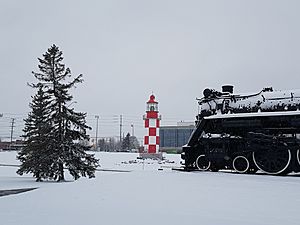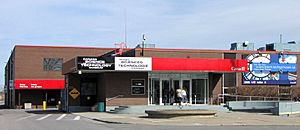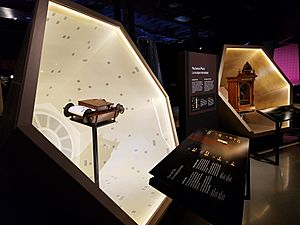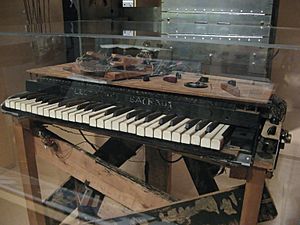Canada Science and Technology Museum facts for kids
| Musée des sciences et de la technologie du Canada | |
 |
|
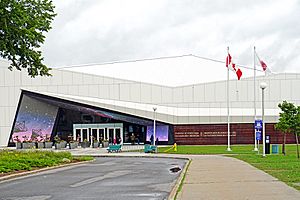
Exterior of the Canada Science and Technology Museum
|
|
| Former name | National Museum of Science and Technology (1968–2000) |
|---|---|
| Established | 1 April 1968 |
| Location | 1867 St. Laurent Boulevard, Ottawa, Ontario, Canada |
| Type | Science and technology museum |
| Owner | Ingenium |
| Ingenium | |
|
|
The Canada Science and Technology Museum (CSTM) is a cool place in Ottawa, Ontario, Canada, where you can explore science and technology. It's a national museum, which means it's important for the whole country! The museum's main job is to keep and share Canada's amazing history in science and technology.
The museum building is quite large, covering about 13,458 square meters (144,860 square feet). It's run by an organization called Ingenium, which also manages two other national museums in Canada.
This museum started as a part of the old National Museum of Canada. It got its own building in 1967 and became its own museum in 1968, first called the National Museum of Science and Technology. It changed to its current name in 2000. The museum building had a big makeover from 2014 to 2017, making it even better for visitors.
The museum has a huge collection of over 20,000 groups of artifacts, with 60,000 individual items! Many of these are on display in the museum's exhibits. The museum also creates and hosts special temporary exhibits and ones that travel to other places.
Contents
A Look Back: Museum History
The Canada Science and Technology Museum began as a special part of the National Museum of Canada. While the National Museum started way back in 1842, its science and technology section was created much later, in 1966.
How the Museum Started
A person named David McCurdy Baird was hired in October 1966 to lead this new science and technology section. He helped design and set up the museum. In April 1967, an old bakery and distribution center in Ottawa was chosen to be the museum's home. It opened its doors to the public on November 16, 1967. In its first year, over 400,000 people came to visit!
On April 1, 1968, the different parts of the National Museum of Canada became separate museums. The science and technology part became the National Museum of Science and Technology. A new group, the National Museums of Canada Corporation, was also formed to manage these new museums.
The museum's first exhibits were inspired by other museums in Europe that focused on hands-on, interactive displays. Some really big artifacts were placed outside the museum. For example, a large Atlas rocket was added in 1973, and a lighthouse from Nova Scotia was brought in 1980. The lighthouse was built in the 1860s, then taken apart and moved to Ottawa!
In 1990, the National Museums of Canada Corporation was replaced. A new organization called Ingenium was created to manage the National Museum of Science and Technology, along with the Canada Aviation and Space Museum and the Canada Agriculture and Food Museum.
The Museum in the 2000s
In 2000, the National Museum of Science and Technology got its current name: the Canada Science and Technology Museum. In the early 2000s, there were ideas to move the museum to a new location, but it stayed where it was.
In 2012, the museum had to make changes to a traveling exhibit after some groups and a government minister had concerns. The museum adjusted the exhibit and added an age limit to make sure it was suitable for all visitors.
The museum had to close in September 2014 because of mold and a wall that was at risk of collapsing. In November 2014, it was announced that the museum would stay closed until 2017 for a huge renovation project costing C$80.5 million. This project updated the inside and outside of the building and added more exhibit space.
During the closure, some large artifacts that were outside, like the Atlas rocket, were taken down. The rocket was even taken apart and destroyed because of rules from its owner, the United States Air Force. The museum lent out some of its exhibits for people to see while the building was being fixed. The newly renovated museum reopened on November 17, 2017.
After the renovations, pictures of people in the Canadian Science and Engineering Hall of Fame were moved online instead of being displayed in the museum. In 2018, the museum paused collecting new large items until new storage facilities at the Ingenium Centre were ready.
Museum Location and Building
The museum is located in Ottawa, near the Sheffield Glen neighborhood on St. Laurent Boulevard. Right next to the museum building is the Ingenium Centre. This center has research labs and storage areas for all the museums run by Ingenium, including the Canada Science and Technology Museum. Before the Ingenium Centre was built, the museum had an observatory there, which was taken down in 2016.
The museum grounds include a 10-acre (4-hectare) park in front of the building with a path leading to the entrance. The park was updated in 2017 with a new landscaping plan.
The Museum Building Itself
The museum first moved into its current spot in 1967, using an old bakery and distribution center. From 2014 to 2017, the building was renovated and expanded to 13,458 square meters (144,860 square feet). The Canadian architecture firm NORR designed these changes. The renovations also included making the building stronger against earthquakes and replacing the roof with one that supports photovoltaic (solar) panels. A new mechanical room was also built to control the temperature better, which helps protect fragile artifacts.
The museum's entrance has a cool, raised roof that is 40 feet (12 meters) high and includes a 1,172 square foot (109 square meter) canopy. The entrance is covered in white ceramic material that also works as a 250-foot (76-meter) long projection screen. In total, about 21,799 square feet (2,025 square meters) of ceramic material was used on the building's outside. Special stone slabs were used with the ceramic tiles to handle the cold weather. These slabs also allowed for sharp angles and smooth surfaces in the design. A short video plays on the LED screen, and a second part of the film is projected onto a flat ceramic wall facing St. Laurent Boulevard in the evenings.
Inside the museum's entrance, there's an interactive light and sound display that looks like the auroras (Northern Lights). The building has five main galleries, a space for temporary exhibits, an artifacts gallery, creative areas, classrooms, theaters, cafeterias, shops, and offices. There's over 80,000 square feet (7,432 square meters) of exhibit space, including a 9,200 square foot (855 square meter) hall just for traveling exhibits. The museum's heating and cooling system is designed with glass walls, so you can see the colorful pipes, making it a cool exhibit itself!
Awesome Exhibitions
The museum has many different kinds of exhibits: permanent ones that are always there, temporary ones that change, and traveling ones that visit other places. Both the permanent and temporary exhibits are designed to be very interactive, meaning you can touch, try, and play with things! While many exhibits are hands-on, you'll also find traditional display cases with cool artifacts.
The museum sometimes works with other Canadian government groups to create exhibits. For example, the Cipher-Decipher traveling exhibit was made with the Communications Security Establishment. Some exhibits also have sponsors, like the ZOOOMobile, a car-building station sponsored by Michelin. Even with sponsors, the museum always controls what goes into the exhibits.
Some of the permanent exhibits include:
- Artifact Alley: This is in the middle of the museum and shows over 700 artifacts!
- Sound by Design: An interactive exhibit where you can try out different instruments and musical inventions.
- The Great Outdoors: This exhibit is all about transportation and fun outdoor activities.
- Medical Sensations: Here, you can see your bone structure, muscles, and blood systems! This exhibit has almost 100 items from the museum's collection, including a special bottle containing the first appendix ever removed in an operation.
- Wearable Tech: This exhibit shows off cool gadgets and clothing you can wear, like a modern amauti (an Inuit coat) and Google Glass.
- Crazy Kitchen: This is the oldest permanent exhibit at the museum and explores how our brains see things. It's been there since the museum opened in 1967!
- Locomotives: The museum has real trains inside! Since the 2017 renovations, these trains are part of an exhibit about steam power, displayed next to a steam engine from a Canadian Coast Guard ship.
Amazing Collections

The museum's collection keeps objects and information about Canada's scientific and technological history. It started with a small group of artifacts from the old National Museum of Canada in 1966. In 1989, the museum decided to focus its collecting efforts on how science and technology changed Canada.
The museum's collection has grown through buying new items and receiving donations. About 90 percent of the items are donated by people who want to share their treasures with the museum. However, the museum doesn't accept donations with special conditions. As of 2021, the museum has about 20,000 groups of artifacts with 60,000 individual objects, plus 80,000 photos and other historical papers. This makes it the largest collection of scientific and technological artifacts in Canada! The items in the collection range from the 12th century all the way to today. Items not on display are kept safe in the Ingenium Centre's storage facilities. The museum's library and archives are also there, shared with the Canada Agriculture and Food Museum.
The collection is organized into eight main groups: communications, computing and mathematics, home technologies, energy and mining, industrial technology, medical technology, scientific instruments, and transportation.
The museum also has several smaller, special collections:
- CN Photo Collection: This has 750,000 photographs, some from as early as the 1850s! It was given to the museum by the Canadian National Railway in 1999.
- Petrovic collection: This includes over 130 artifacts like rulers, compasses, and other measuring tools from the 12th to 19th centuries. The museum bought it in 1980.
- Radio artifacts: A collection of 70 radio-related items.
- Kites: A collection of 60 kites, mostly from Asia.
The museum's medical collection has over 8,000 items, many from the former Academy of Medicine Collection. In 2021, the museum started a special collection related to the COVID-19 pandemic. This includes items like the Pfizer–BioNTech COVID-19 vaccine and the 10-millionth face mask made at a Canadian factory.
If the museum decides to remove an item from its collection, it must be approved by its board and offered to another museum first.
Cool and Famous Items
Here are some of the most interesting items in the museum's collection:
- Transportation:
* The last spike used to complete the transcontinental Canadian Pacific Railway. * A McLaughlin-Buick car and a special railway car used during the 1939 royal tour of Canada by the King and Queen. * The Bras d'Or prototype hydrofoil, a boat that lifts out of the water. * Two nocturnals, old tools from the 17th century used to tell time at night. * A Popemobile, donated to the museum in 1985. * The Henry Seth Taylor steam buggy, which was the very first car made in Canada! The museum got it in 1984.
- Computers and Calculators:
* Two Millionaire calculators, which were very advanced for their time. * The DRTE Computer, a very early computer given to the museum in 1968.
- Other Cool Inventions:
* An electronic sackbut, an early electronic musical instrument. * The first electron microscope made in North America. * Canada's largest refracting telescope, from the Dominion Observatory. * The original hitchBOT, a robot that traveled across Canada. * George Klein's first prototype for the world's first motorized wheelchair. The museum got this important item in 2005.
Research and Learning
In its first 20 years, the museum mostly collected different types of machines and studied how they worked. But in the 1980s, it started to focus more on how these technologies affected people's lives and Canadian society.
The museum also hosts a research center for the University of Ottawa called The Living Lab. This lab gives university researchers a place to study children in a natural setting, not just a lab.
The museum publishes an academic journal called the Material Culture Review with the Canadian Museum of History. This journal shares research about historical items found in Canadian museums.
See also
 In Spanish: Museo de Ciencia y Tecnología de Canadá para niños
In Spanish: Museo de Ciencia y Tecnología de Canadá para niños
- List of museums in Ottawa
- List of science museums


